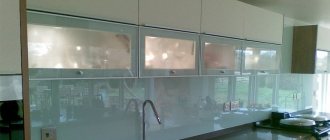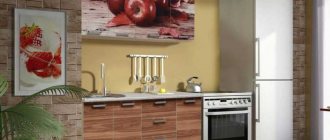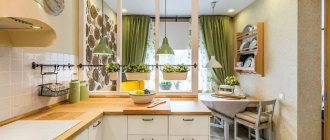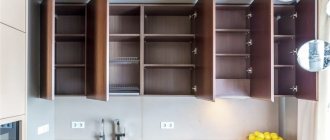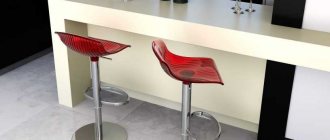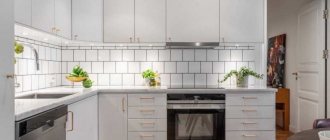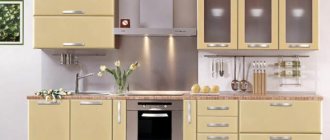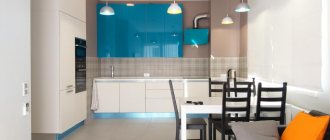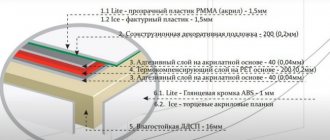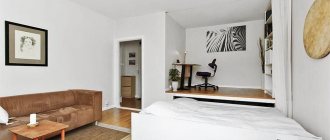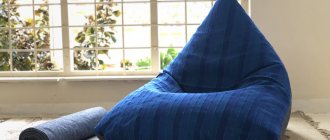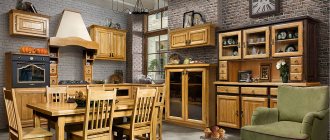Frame facades based on MDF profiles: create your own furniture design
Principles of using MDF frame facades
Due to the fact that MDF frames do not require a lot of material and are quickly manufactured , their cost will suit many connoisseurs of beauty and savings at the same time. MDF frames are cut from the board, trimmed at an angle of 45 0, and supplemented with special grooves for fastening to each other. They are then processed using machines to give them the required shape and design. Using a special milling cutter, a groove 8 mm wide is cut into the thickness of the slab, into which any material can be inserted. It is this property that allows the use of various materials to fill the MDF profile.
This simple method of processing MDF boards was discovered in 1966 in the USA, thanks to which today you can see a huge selection of frames in texture and color. Despite the fact that this method of creating facades is not new, its versatility and affordable price are suitable for many families. After all, to fill the façade you can use any material and play with different combinations and textures.
MDF frames can be used to make not only kitchen sets, although they are used most often here. You can also order the production of shelving fronts for the living room, a closet in the hallway, shelves with transparent or mirrored fronts for the bathroom . In general, you can use the principle of MDF facades to decorate almost any cabinet furniture.
The ease of manufacturing MDF profiles allows you to use them for decorating doors yourself . All you need to do is purchase ready-made profiles without recesses, a special machine. Then, with its help, you can cut out an 8 mm recess - this is the standard option. For non-standard fillers, such as glass, you can use a machine with a finer bit to create a groove up to 4mm wide. Although, to use glass as a profile filling, special seals are used . As you can see, decorating cabinet furniture doors is not only easy, but also affordable. You can easily create a unique design if you have imagination and some skills.
Advantages and disadvantages
If we talk about the advantages of using frame facades made of MDF, there are quite a lot of them, given the low cost of products . And the most important thing, perhaps, for many aesthetes is the design possibilities. Many manufacturers offer different types of profiles. For example, in addition to traditional wood imitation, you can use solid colors of a different spectrum, from white to black. Thanks to the use of film, with which prepared frames are covered and color profiles are created . Also, many manufacturers offer veneer as a coating; this is considered a more environmentally friendly and expensive option. In this case, veneer is most often used to create a single color scheme with the rest of the furniture design : side panels, tabletops, etc.
Milling is also used to create a unique design at minimal cost; it is used to create patterns, chamfers, and rounded edges on the surface of the frame . Of course, you can use a raw, smooth surface, which is suitable for maintaining a modern postmodern or high-tech style. You don’t have to worry about increasing the cost of the headset if you use non-standard large sizes of MDF frame profiles. Even decorating a large cabinet door with MDF frames won't cost you much more than using smaller frames for an upper kitchen cabinet. The only thing you have to spend money on is filling .
So, what filling can be used for frame facades?
- Chipboards are a cheap option , but they allow you to create compositions. For example, the frame is mahogany color, and the insert is imitation birch or alder. Also, instead of chipboard, MDF boards are combined, which is more beneficial from a practicality point of view.
- Glass is mainly used dense and embossed to create the effect of opacity. You can also use a mirror, colored or frosted glass, but the cost of the finished product will increase.
- Natural rattan will look great in the living room against the background of a wardrobe. And self-production will add special value to the finished product.
- Plastic can be used to decorate furniture in any room, as its color palette is huge and the price is reasonable.
The combination of several materials for decorating one facade opens up a lot of possibilities for furniture design, and therefore the interior. Another advantage of MDF frame facades is their relative lightness compared to facades made of wood and MDF boards. This ensures that the door hinges work properly. Also, if for some reason a defect appears on the frame, you will not have to completely change the facade. All that is necessary is to disassemble the structure and replace the frame with a new one - quickly and at no extra cost.
The disadvantages of MDF frame facades include poor wear resistance - they quickly lose their appearance and require regular replacement. When using such facades near the oven and stove, the film may peel off under the influence of high temperature and humidity.
Also, if installed incorrectly, there is a possibility of weak attachment of the frames to the base.
FURNITURE FACADES FROM MDF PROFILES FOR COMPLETING FURNITURE AT A BENEFITABLE PRICE
Our company produces furniture facades from MDF profiles wrapped in tree-like PVC films with various inserts. The wide range of inserts that we can offer is due to the fact that we can produce for these purposes not only parts from laminated chipboard, but also from MDF covered with films and plastics. In addition, parts lined with rattan, tapestry, artificial leather, as well as any patterned or painted glass or glass with photo printing can be inserted into MDF profile frames.
"Profile 2201"
"Profile 2205"
General information
Scope and characteristics
Now, as mentioned earlier, MDF is considered a common material in the manufacture of furniture. Thanks to modern processing, including lamination, they make it even more in demand.
Frame profiles are used in the manufacture of any cabinet furniture, but are most often used in the creation of kitchen cabinets. They are used to create the front of a drawer or hinged door in kitchen units, as well as in narrow cabinets, as a fixed decorative element of various furniture.
MDF has the following characteristics:
- resistance to dirt and scratches;
- resistance to ultraviolet radiation;
- easy to maintain;
- repels moisture;
- shock resistant;
- environmentally friendly;
- resistant to chemicals.
Facade structure
The main element in a frame profile is a frame made from a profile. Blanks for the frame are cut out of MDF boards, then milled and given the desired appearance. The surface can be smooth or textured. A groove is made on the inside of the profiles into which the façade filling is inserted. The facade can be laminated using PVC films, finished with veneer or treated with paint.
The components of the frame are cut at an angle of forty-five degrees, and grooves are made in them for fastening. Additional brackets are installed at the connection points.
The material already planned by design is inserted into the grooves of the finished frames. It can be MDF, glass, mirror, plastic, etc.
Pros and cons of such facades
Benefits include:
- manufactured using simple technologies;
- are relatively inexpensive;
- aesthetic appearance;
- the ability to combine different materials, colors and textures;
- these facades can be used in a variety of furniture;
- the design is not heavy;
- can be made in non-standard sizes.
With a large number of advantages, unfortunately, there are also disadvantages. This most likely applies to kitchen furniture, which is always subject to increased demands due to the nature of its use. Such furniture must be resistant to high humidity and high temperatures, not lose its appearance when in contact with acids and fats, have increased wear resistance, and not deteriorate when washed with cleaning agents.
Important: The reliability of specific furniture will depend on the quality of the profile coating and the filling of the facade.
Probably one of the most reliable options would be to use a painted facade.
But, any prints are very clearly visible on the laminated surface. Therefore, such surfaces require regular maintenance. One of the commonly used finishing methods is lamination using PVC films, but they have the peculiarity of peeling off from the frame, because it does not have good resistance to high temperatures and hot vapors.
Note: Natural veneer is also not a guarantee of the durability of your kitchen profile, since it is weak to moisture.
A common problem with all frame-type facades is the seam joints, which are very vulnerable to moisture, especially if the fastenings are weak. Regular contact with moisture causes the frame to deform.
Features of the production of frame facades from MDF
Assembly steps:
- profile markings;
- cutting according to marked dimensions;
- milling of mounting grooves for dowels;
- assemble corner joints by direct gluing, install a dowel;
- the insert is mounted - filling.
To connect frame profiles, it must be cut at an angle of forty-five degrees, and their joining must be of high quality and have no visible gaps.
You can cut the profile using the following methods:
- Manual using a miter box. This is the most optimal option for domestic use;
- Cutting with electric end plate;
- Using a sawmill.
With high-quality performance of any of the listed methods, a high-precision connection can be ensured.
Cutting on a miter box is done as follows:
- The profile is placed tightly in the miter box;
- Sawing is done using a hacksaw;
- Afterwards the cut is cleaned with sandpaper.
Note: To cut the profile, it is better to take a miter box made of metal. The wooden and plastic version will not work, because during long-term use such tools are not capable of creating accurate positioning of the hacksaw, and therefore an even cut.
The simplest method is cutting with a miter saw.
Here the sequence is as follows:
- The profile sheet is placed tightly to the limiting element;
- The cutting disk is lowered to the profile and here the correct installation of the workpiece and its size are determined;
- Then the saw is turned on and the cutting disc is used to cut;
Features of the design of kitchens made of framed MDF
Frame facades are not solid. They are assembled from ready-made elements: frame parts and internal inserts (panels, glass, etc.). The ends of the frame parts are cut at an angle and glued to each other. For metal frames, they use not adhesive, but a mechanical connection (on fasteners). The inner edge of the frame has grooves for inserting filling. The width of the grooves and the thickness of the insert are made the same, they are carefully adjusted so that the central part does not rattle. The joints between the frame and the insert are additionally glued.
Otherwise, the design of kitchens made from framed MDF is standard. For frame facades, the same fittings are used as for panel ones (handles, hinges, etc.). The supporting structures of kitchen furniture and internal filling are selected separately according to customer requirements.
All about frame facades
The modern style of the house is formed by various interior and decorative elements. Furniture facades play the most important role. The overall impression of the room depends on the appearance of the furniture. One of the popular design options is framed facades. Combined furniture elements, thanks to their unusual finish and texture, will decorate any interior.
The frame facade consists of two components - decorative finishing and a “load-bearing” layer. As a rule, durable, practical material is used as a base. Natural wood, aluminum, chipboard and other options are used in exterior decoration. Typically, a frame façade is named after the material used in the decorative finishing.
Types of furniture facades. Market Trends
The market for kitchen fronts today is more diverse than ever. Furniture manufacturers understand that you can attract the buyer’s attention with the beautiful appearance of the kitchen, or with its functional “filling”. The facades form the first overall impression of the kitchen, forcing the buyer to stop and look at which drawers and baskets are more convenient for him to use, and what interesting technical or ergonomic solutions are offered.
Painted and film facades are widely represented on the furniture market; now they are sales leaders in their price segments. There is quite a strong demand for new materials, new effects on the surface of the facade - be it gloss or aging patina, leather inserts or photo printing. But the share of frame facades in furniture production has recently been growing at a fairly low rate, according to experts, and in some regions of Russia is even decreasing. Many people associate this factor with the actively developing market for other types of facades, from which you can choose a wide variety of options in terms of design and functionality.
However, it is still too early to say that frame facades are becoming a thing of the past. We estimate the share of frame facades at approximately 20%, this includes MDF and AL frame facades. At the same time, if the share of frame MDF facades has decreased slightly, the share of aluminum facades, on the contrary, is growing. But this does not mean that the demand for MDF frame facades will continue to decline, they have simply occupied their niche.
Types of frame facades
- Film (based on MDF and chipboard).
- Laminated (from chipboard).
- Painted (MDF).
- Aluminum.
- Plastic.
- Made from natural wood.
How to choose the best option? There is no universal solution; it is necessary to evaluate the advantages and disadvantages of each type.
Film frame facades
This type of design is considered the most budget option. As a rule, a chipboard base is cheaper than MDF options. But the quality of such materials is lower, and the binding components are substances harmful to health. Dry sawdust in MDF is glued together with natural lignin, which is formed when wood waste is heated.
A specially prepared film is applied to the base. Typically, polyvinyl chloride is used. The film can be plain or with a pattern, or have a different structure (imitation wood, natural stone, various metals).
Film surfaces have several disadvantages. The most obvious is the "artificial" appearance. In addition, when furniture is heated above 70 degrees, the film peels off. Partial repair of such damage is impossible; a complete replacement is necessary.
Painted frame facades (MDF)
The frame base is painted with polyurethane enamel. This finish is more expensive than film options. Paint is applied manually or automatically.
The customer can choose a shade from the RAL catalog (more than 200 colors), matte or glossy surface appearance.
The following additional effects are available:
The polyurethane coating is resistant to high temperatures and vapors rising from cookware on the stove. The disadvantages of paint are fading in the sun with constant exposure to rays and the likelihood of scratches and chips during use.
Frame facades made of laminated chipboard
Laminated chipboard is a popular material option for the production of inexpensive furniture. Several layers of melamine paper prevent the release of formaldehyde into the atmosphere. Most often they order designs with imitation wooden surfaces.
The disadvantage of laminated chipboard is the poor resistance of melamine paper to high temperatures, so furniture is placed quite far from the stove and sink. Over time, the elements may become deformed under the influence of their own weight and the fittings may fall out.
Aluminum frame facades
Aluminum is an ideal material for a kitchen in a loft or high-tech style. Aluminum inserts are combined with natural wood veneer or painted MDF surfaces. Aluminum is resistant to high temperatures, boiling water, steam and sunlight, but is scratched, loses its shine and becomes dull over time.
Plastic frame facades
During the production process, roll or sheet plastic is applied to the surface of chipboard (fibreboard). The edges are processed on an edging machine. Furniture surfaces made of plastic are considered the most suitable option for families with small children. They are resistant to mechanical damage, scratches, abrasion, moisture and high temperatures, reliable and durable.
Film facades made of chipboard and MDF
One of the most affordable, simple and budget options. If you choose chipboard as the base, the final price will be lower than if you choose MDF. This is due to lower quality and the addition of harmful substances to the material. MDF is considered a natural and safe type, since the dry sawdust in its composition is glued together thanks to lignin - a substance that is naturally released from wood when heated.
A special polyvinyl chloride film is glued onto the prepared sheet material base. The technology of this process is automated and cannot be reproduced at home. In terms of external qualities, the film can be either monochromatic or contain drawings, imitating the structure of metal, stone, wood.
The main advantages of this type of facade include:
- inexpensive compared to other alternative options;
- wide choice of colors and decor;
- good wear resistance;
- low susceptibility to mechanical damage from sharp and blunt objects;
- easy care - absolute tolerance to detergents without abrasive particles.
The most obvious disadvantages of film frame facades include the artificial appearance of the headset. No matter how accurate the imitation of wood structure may be, such framed facades can never be confused with natural wood. In addition, at temperatures of 70° and above, the film begins to peel off. Partial repairs are practically impossible. If defects appear, the facade will have to be completely changed.
MDF facade profile
Most often it is the final chord in the manufacture of furniture. In addition, it is used as a semi-finished product in the creation of various furniture parts.
What are the profiles:
- facade inserts
- cornices
- sides for a wardrobe or table
- overlay
- profile for drawers or beds
- MDF frame profile
- “patina” profiles.
The profile can be covered with the following facing materials:
- wood veneer. In the process of veneering an MDF profile, the wrapping method is used, which gives the profile or cornice a complete appearance. Used to thicken the edge of a panel element, frame or cornice, as decorative or overlay furniture elements, for door frames, plinths, wall panels
- wood veneer with finishing
- “Patina” film, which creates an aging effect and makes this façade stand out from others. This facade is very similar to natural wood. Such pieces of furniture are distinguished by elegance. A PVC film is applied to the facade, which is covered with patina and varnish.
- PVC film. This film is resistant to aging, mechanical and chemical action, temperature changes, and direct sunlight. Gives the material strength and is stain resistant. It can be transparent or pigmented, for example, with a wood grain pattern, glossy or matte, hard or elastic, smooth or deeply textured. This coating can imitate any surface
- CPL film. CPL is the latest technologically advanced laminated plastic, which is produced using a completely different technology than conventional decorative coatings, for example, finish films, decorative papers. Products coated with such a film are characterized by high durability, wear resistance, resistance to fluctuations in temperature and humidity levels
- finishing film. This option is the most budget and low-quality. In fact, it is paper that has been treated with a thermosetting resin. This coating remains attractive for a very short time. High sensitivity to wet cleaning. The film quickly loses its appearance and ceases to be a decoration of the room.
MDF frame profile
The segment of frame facades in furniture manufacturing is quite wide and does not cease to expand. Such facades are distinguished by their attractive appearance and ease of manufacture in comparison with other types of facades.
Chipboard, decorative glass and mirror, translucent plastic, eco-leather and many other materials can be used as an insert under the frame. These materials are inserted into the profile using a special seal. The MDF frame is firmly and securely glued together, after which it forms a single structure that can withstand a long period of use.
The profile thickness ranges from 16 to 22 mm, and the width from 50 to 80 mm. The grooves of such profiles make it possible to mount filling with a thickness of 4 mm, for example, glass or mirror, up to 10 mm, for example, facade laminated chipboard. With a filling thickness of up to 10 mm, installation is carried out together with a special silicone seal.
Since frame facades are made from MDF, their environmental performance is much superior to facades using wood chips, and imported frame profiles and fillings lined with PVC film that have appeared on the domestic market compete with other facades in terms of water resistance and resistance to mechanical damage.
Creating such facades is absolutely problem-free. For film facades there is a problem of non-standard sizes. As a result, it is possible to create products of any size in 1 mm increments, which is of great importance in the manufacture of custom-made furniture. If the frame is damaged during operation, it can be dismantled and replaced with a new one. At the client's request, specialists can process the facade on a milling machine to create absolutely any pattern on its surface.
MDF profile for facades is a highly environmentally friendly material, because the basis of the material is wood fibers, previously dissolved and dried. Synthetic adhesives are not used for gluing. The main adhesive is lignin, which is formed from timber when heated.
Main characteristics of MDF frame facades
In furniture production, such solutions have begun to be used quite often. The finished items are not only beautiful, but also multifunctional. Equipment for the production of frame facades is quite cheap, so even small workshops are engaged in their production. You can even make some details yourself.
Frame facades made from MDF have excellent environmental characteristics. In addition, the products are not at all afraid of high levels of humidity and other negative factors that can cause damage to other materials.
Frame facades made of MDF can be of any size, so the process of their manufacture does not involve any difficulties. This is what influenced the fact that some buyers prefer to order furniture according to an individual project, taking into account the features of their premises.
Using profiles of different sections, you can get facades that are completely different from each other. The range of shades will give you the opportunity to fantasize and select those options that are ideal for a particular interior.
You can use different materials as an insert. Mostly people choose tempered glass or a mirror surface. This is what distinguishes frame MDF from other materials. Many buyers have appreciated their advantages, so it’s worth paying attention to such material.
